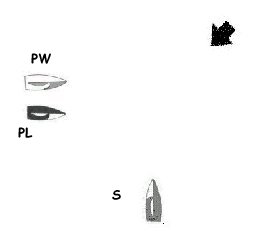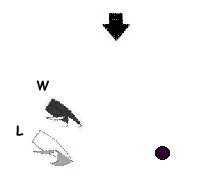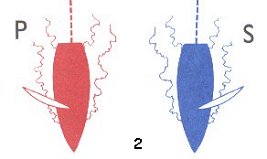|
As We Meet Them in a Typical Wayfarer Race (updated 9 Jan 2017) What follows is my
brief
summary of the situations we encounter most
often
in our Wayfarer races. Special thanks to Dave
Dellenbaugh of
the excellent Racing Newsletter Speed
& Smarts for permission to copy and
use some of his boat
diagrams. I can't praise enough, Dave's
explanations
of the intricacies of
racing to do them
justice,
and I highly recommend Speed & Smarts
to all serious
racers.
In the latest version of our Rules (2017-2020), the philosophy of
our
game remains unchanged - with overriding emphasis on safety
(both
yours and that of others who may need your help) and fair,
sportsmanlike
sailing. These RRS stress the following: Don't use our
beloved water as a trash can!!
(rule 55) The overriding emphasis on avoiding collisions remains unchanged - especially those that could cause damage. Rule 14 (Avoiding Contact) indicates that, once it becomes clear the burdened boat will not be keeping clear, the right-of-way boat shall avoid contact if reasonably possible. There is however no penalty for the right-of-way boat unless a collision that could have been avoided actually causes damage or injury. DEFINITIONS: Three definitions deserve very special attention since they affect the interpretation of a number of crucial rules: Room
is: The space a boat needs in the
existing
conditions, including space to comply with
her obligations under the rules of Part 2 and rule 31,
while manoeuvering promptly in a seamanlike way.
Mark-Room
and Keep Clear have been
fine-tuned:
Keep
Clear A boat keeps clear of
a right-of-way boat One other
crucial and unchanged definition
is:
An example of
this
would be a run where a boat within 2 boat lengths of
me is steering a
course to pass me to leeward. Let us assume that boat
establishes a
leeward overlap within 2 lengths of me. While that
situation exists,
Leeward is not permitted to sail above his proper
course. An obvious
proper
course
here
would be the straight-line course to the next mark.
When I am on the Protest Committee, I tend to look for some consistency in and/or valid reason for the course - i.e. the boat claiming to have sailed proper course in the example above should have been allowing for current or sailing "up in the lulls, down with the puffs", etc. before the windward boat became an issue. Another example of a valid reason for a proper course that departs from the obvious shortest course would be the following: I am inside at the gybe mark and am supposed to gybe in such a way that I sail proper course (as per Rule 18.4). It is however, a windy day, and I wait for a surfable wave on which to gybe. Because this move reduces wind pressure (and the risk of capsize!) during the gybe, I can defend this as my proper course since it is the same course I would sail if no other boat were near by. Finally, if you are going to be selective about how much time you want to spend on learning the Rules and do not want to memorize all the definitions, here are two more of them that it pays to be very familiar with:
With 8 minutes to go to the Wayfarer start, I am sailing along on a starboard tack reach about 30 metres behind the line. I meet a port tack Fireball who starts in 3 minutes. The latter bears away and goes to leeward of me. Do I hear you
ask:
"So, what's wrong with that??!!" Well - have a look at
rule 23.1
which says What this says to me is that, from now on, I'm going to be much more careful not to interfere with any boat that is racing - both before I start racing and after I stop racing in any particular race. There is even mark-room when you're
just
dawdling around before the start We should also remember that there is no proper course before the start signal goes! This means that - subject to the limitations of rule 15 (Acquiring Right of Way) and 16 (Changing Course), even a leeward boat that came up from clear astern is entitled to luff a windward boat head to wind if she so desires (although she must do so in a way that gives windward room to keep clear). THE BEAT:
AT THE
WINDWARD
MARK: Beware of trying to tack to starboard in a crowd right at a mark to be left to port! Even if you ‘legally’ complete your tack in front of a boat but are (with any part of your boat!!) inside the Zone when you complete your tack, rule 18.3 applies. You are fouling if the other boat which is now coming up from astern and laying/fetching the mark, either has to luff above close-hauled or bear away and fails to properly pass the mark because she was avoiding a collision with the slower moving YOU! See rule 21. It is a good rule of thumb that we should avoid tacking to starboard in(to) the Zone unless we are sure you can do so well away from all other boats! Buoys to Starboard: Rule 18 does not often
give you immunity to
tack
at a mark Thus, even if
you get to the
windward
mark on starboard tack just ahead of another starboard
tacker, you must
keep clear of the other starboard tacker while you are
tacking.
To play it safe, what you do is briefly luff up to near
head-to-wind
right
at the mark if there is a boat very close behind you.
Once he starts to
go by you to leeward, you can then complete your tack.
It is also worth
noting that, once you have started your tack, rule 16
prevents a boat close astern from altering course if
such an alteration
prevents you from keeping
clear. This same approach works if you need
to tack around a buoys-to-port windward mark. Hitting the mark: If you should hit any mark (forbidden by rule 31), rule 44 says that you must get "well clear of other boats as soon as possible" and do one turn including one tack and one gybe. As with a Two-Turns Penalty, if the Turn is not done as soon as possible, you might as well not have done it for all the good it'll do you in a potential protest! If, God forbid, you should hit a mark and foul another boat in the same incident, you need only do a Two-Turn Penalty, not three turns. The Two-Turn Penalty is the maximum penalty for any one incident (rule 44.1(a)) unless you "caused serious damage or gained significant advantage", in which case the One- or Two-Turn Penalty is not available to you and you must retire (rule 44.1). THE REACH: Rear-ending another boat is in the same category as rear-ending another car. No matter how dumb the other guy may have been, legally you're in the wrong (rule 12). THE GYBE
MARK: If two (or more!) boats are overlapped, the inside boat (leeward) is also the right-of-way boat and is thus entitled to make a “proper course” rounding (i.e. wide and close). However, the inside boat must gybe in accordance with the requirement to sail proper course (rule 18.4) - unless of course the wind has shifted or the course is skewed such that the second reach is very broad in which case the inside boat would be entitled to merely bear away to what she considers to be her proper course. NOTE 1: If you claim a late change
in overlap
status - i.e. that you established or broke an overlap
just before you reached the Zone
- and the other boat disagrees, you should take his/her
word for it
unless
you have reliable witnesses to the contrary, since 18.2(e)
states that "it shall be presumed" that the change took
place too late! If two boats are not overlapped
as they are about to round a mark, the boat clear
astern must keep
clear
while the boat clear
ahead
rounds the mark except that the boat clear
ahead is never given carte blanche to tack
around the mark -
i.e.
she is always subject to rule 13
(While
Tacking). A tactical (wide-and-close) rounding by
a right-of-way (leeward or clear ahead) boat entitled to
mark-room. If the entitled boat misjudges the rounding
and leaves enough room, the other boat can try to
squeeze through, remembering that the mark-room boat is
entitled to sail proper course which is probably
anything up to close-hauled but not beyond (i.e. you
can't sail above close-hauled any more to "close the
door"). THE LEEWARD MARK:
Beware! Rule 18.2(a) merely tells the outside right-of-way boat that she must give the inside boat mark-room (i.e. sufficient room to round or pass the mark - i.e. enough room to make a “seamanlike” rounding (close and close) as per the definition of room. In easy sailing conditions (flat water, moderate winds), a seamanlike rounding would likely be one in which W should, at all times during the rounding, be able to reach out and touch the mark. THE RUN: The run
brings
about four
situations that
do not normally happen on a reach:
THE FINISH:
If you intend to protest an infraction committed on the course, there is now no need to show a protest flag on a boat less than 6 metres long but you must as soon as possible, clearly indicate your intention by yelling the actual word: "Protest!" - - - “words to that effect” are not considered clear enough! If the boat you intend to protest is too far away to hail (e.g. hits a mark 100 metres away from you in noisy, windy conditions), you must inform them of your intention to protest at your first opportunity. Unless the SI's make it mandatory, ou need not inform the Race Committee of your protest as you finish but it is considered wise, after you have finished, to draw their attention to the fact that you are protesting someone. |



